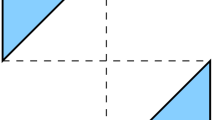Abstract
In the problem ofparts feeding we are given a class of feasible operations for reorienting a part, and we are asked to find a fixed sequence of these operations which is guaranteed to bring the part into a known goal orientation from any possible initial orientation. Goldberg addressed this problem in [2], and showed that, for planar polygonal parts, there is always a sequence of simple operations which can be performed by a simple parallel-jaw gripper, which is guaranteed to orient the part (up to symmetry) without the use of any sensor information; he also conjectured thatO(n) steps are sufficient.
In this paper we prove Goldberg's conjecture by explicitly constructing plans of at most2n − 1 steps for orienting polygonal parts in this model. We also give a lower bound on the number of steps required for such plans to show that this upper bound is tight.
Finally, we extend these results to the problem ofdistinguishing among a finite set of parts using minimal sensing. Specifically, we assume that we are given a set
of known polygonal parts, and a parallel-jaw gripper able to sense the distance between its jaws upon closure. We construct a simple oblivious plan of linear complexity which, when presented with a polygonal part
, determines the index of this part.
Similar content being viewed by others
References
Y. B. Chen and D. J. Ierardi, Oblivious plans for orienting and distinguishing polygonal parts.Proceedings of the Fourth Canadian Conference on Computation Geometry. St. John's, Newfoundland, 1992, pp. 204–209.
K. Y. Goldberg. Orienting polygonal parts without sensors.Algorithmica, 10:201–225, 1993.
B. K. Natarajan. Some paradigms for the automated design of parts feeders.International Journal of Robotics Research, 8(6):98–109, December 1989.
R. Cole and C. Yap. Shape from probing.Journal of Algorithms, 8(1): 19–38, 1987.
A. Rao and K. Y. Goldberg. On the recovery of a polygon's shape from its diameter function.Proceedings of the Fourth Canadian Conference on Computational Geometry. St. John's, Newfoundland, 1992, pp. 210–215.
K. Y. Goldberg and A. Rao. Orienting planar parts. Technical Report 275, Institute for Robotics and Intelligent Systems, USC, 1991.
R. C. Brost. Automatic grasp planning in the presence of uncertainty.The International Journal of Robotics Research, December 1988.
K. Y. Goldberg. Stochastic Plans for Robotic Manipulation. Ph.D. thesis, School of Computer Science, Carnegie Mellon University, August 1990.
G. Boothroyd, C. Poli, and L. E. Munch.Automatic Assembly. Marcel Dekker, New York, 1982.
M. A. Erdmann and M. T. Mason. An exploration of sensorless manipulation.Proceedings of the IEEE Conference on Robotics and Automation. Washington, DC, 1986, pp. 186–196.
M. Erdmann, M. T. Mason, and G. Vanacek Jr. Mechanical parts orienting: the case of a polyhedron on a table.Proceedings of the International Conference on Robotics and Automation. Sacramento, CA, April 1991.
D. Eppstein. Reset sequences for monotonic automata.SIAM Journal on Computing, 19(5): 500–510, 1990.
D. D. Grossman and M. W. Blasgen. Orienting mechanical parts by computer-controlled manipulator.IEEE Transactions on Systems, Man, and Cybernetics, 5, 1975.
J.-C. Latombe. Motion planning with uncertainty: on the preimage backchaining approach. In O. Khatib, J. J. Craig, and T. Lozano-Perez, eds.,The Robotics Review, Vol. I, pp. 53–70,1989.
M. T. Mason. Manipulator Grasping and Pushing Operations. Ph.D. thesis, Carnegie Mellon University, 1982.
M. T. Mason, K. Y. Goldberg, and R. H. Taylor. Planning sequences of squeeze-grasps to orient and grasp polygonal objects. Technical Report CMU-CS-88-127, Computer Science Department, Carnegie Mellon University, April 1988.
B. K. Natarajan. On Moving and Orienting Objects. Ph.D. thesis, Department of Computer Science, Cornell University, 1986.
B. K. Natarajan. Some paradigms for the automated design of parts feeders.International Journal of Robotics Research, 8(6):98–109, Dec. 1989.
M. A. Peshkin. Planning Robotic Manipulation Strategies for Sliding Objects. Ph.D. thesis, Department of Physics, Carnegie Mellon University, November 1986.
B.-Z. Sandier.Robotics: Designing the Mechanisms for Automated Machinery. Prentice-Hall, Englewood Cliffs, NJ, 1991.
Author information
Authors and Affiliations
Additional information
Communicated by C. H. Papadimitriou.
This research was supported in part by the NSF under Grant CCR-9207422, and by a Zumberge Fellowship. A preliminary version of this paper appeared in theProceedings of the Fourth Canadian Conference on Computational Geometry [1].
Rights and permissions
About this article
Cite this article
Chen, YB., Ierardi, D.J. The complexity of oblivious plans for orienting and distinguishing polygonal parts. Algorithmica 14, 367–397 (1995). https://doi.org/10.1007/BF01192046
Received:
Revised:
Issue Date:
DOI: https://doi.org/10.1007/BF01192046




